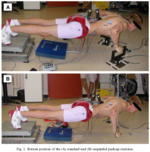
There is a 100 Push-up Challenge taking place over at the Get Fit Slowly blog community. The participants of the challenge are using a protocol to slowly build their push-up fitness. Push-ups are a difficult exercise, and many people have trouble doing them. The military uses the push-up as a global strength measure due to its ability to predict success in military tasks. But, push-ups can place the shoulders at risk, and may even rough up your back. It’s worth asking a couple questions: Are the fitness gains made doing push-ups worth these risks and, is there anything that can be done to improve the success of those undertaking the push-up challenge ?
What are you strengthening, really?
 While it is intuitive that push-ups strengthen your arms, they do much more than
While it is intuitive that push-ups strengthen your arms, they do much more than
that! Push-ups are often used in late stages of rehabilitation for the work they do strengthening the chest and shoulders, specifically the scapular stabilizing muscles. Push-ups get a large amount of muscle activity in the upper trapezius muscle and the serratus anterior muscle. Additionally, and most importantly, push-ups work your body’s core muscles around the spine. As you do a push-up, gravity wants to make your back sag. Keeping a nice, neutral spine requires a lot of abdominal muscle control, which can help to reduce low back pain. This study suggests that a suspended push-up, where your hands are placed on a mobile surface like rings, provoke even more abdominal control, but also increase the load through the joints in your spine making this version of the push-up only good for healthy backs and strong cores. A strong core, of course, is important for preventing low back pain.
Are push-ups a danger to the shoulders?
In short, YES! Our arms are made for pushing, but in very specific positions. As you get to the bottom of a push-up, the shoulder moves more towards extension. When your arms are spread wide, this movement puts the shoulder in a precarious position. The worst case is a risk of shoulder dislocation. A less violent, yet more common occurrence is that the delicate tendons and joint capsule of the shoulder is over-stressed in this position, causing inflammation and pain. You can minimize the risk to your shoulders by going slow, stopping when your upper arms parallel with your body (don’t let your elbows go past your torso, as in the picture above), and keeping your arms somewhat close to your body, but your hands neutral or turned outwards (turned in stresses your elbow). If you keep good alignment and listen to your body over a dictated “preferred” form, push-ups can be good for your shoulders.
What to do on off days?
Since the 100 Push-up protocol calls for push-ups 3 days a week, that leaves 4 days to do something else. While your muscles need time to recover, especially after a challenging task of push-ups, doing some simple cross-training can speed up both recovery and performance. I would recommend aerobic exercise always, but also doing some non-arm-based core training on off-days. Example: crunches, swiss ball workouts, or hip and leg exercises like a leg press. Keeping your body moving on recovery days is the concept behind “active recovery” which is the preferred method of rest when training.
Warning Signs?
Doing too many push-ups too quickly can get you into trouble. The main spot of concern is the shoulders, of course. It is important to differentiate muscle soreness from injury-related pain. Injury pain is usually more focused in one spot and more intense. Muscle soreness goes away after a day or so, but injury pain returns when the activity is performed again or does not go away. If you’re doing the 100 Push-up Challenge and you feel some pain, please take a week off. Yes, not just a day, a whole week! In my clinical experience, it is much better to be conservative with inflamed shoulder structures than to challenge them. It could be that the small, but honest break will enable you to keep pace overall. Not taking that break can get you into some chronic pain trouble and doom your chances altogether.
Good luck!








